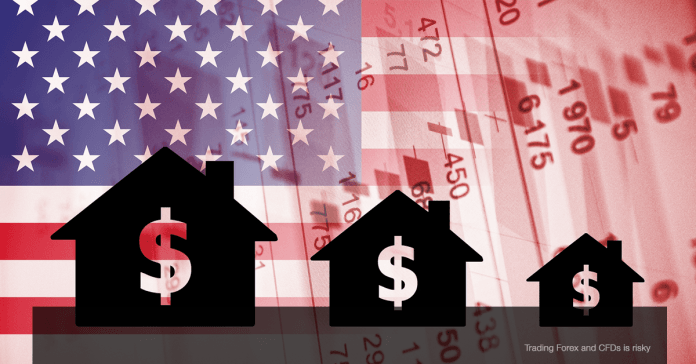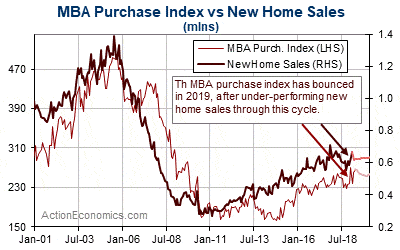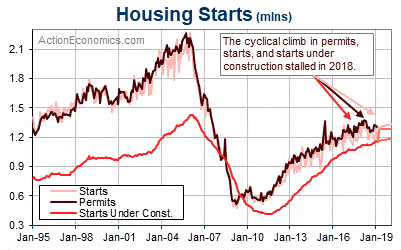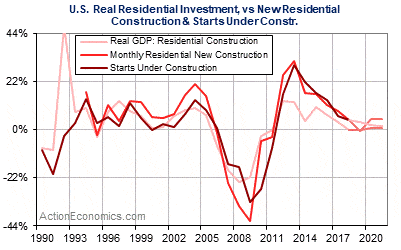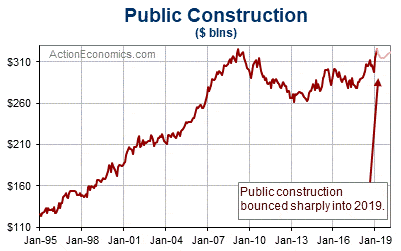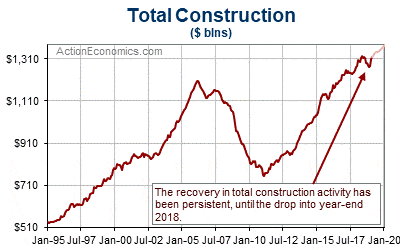Housing starts from US, the only piece of economic data for today, released earlier, presenting the slowest pace since May 2017.
US housing starts fell 0.3% to 1.139 mln in March, extending the 12.0% drop in February to 1.142 mln, and the January 1.273 mln. Single family starts remained weak, sliding 0.4% on top of the -19.0% previously. Multifamily starts were unchanged after rising 8.9%. Meanwhile, Building permits declined 1.7% to 1.269 mln following the 2.0% decline to 1.291 mln in February (revised from 1.296 mln). Starts were lower in 3 of the 4 regions, falling 17.6% in the Midwest, 7.2% in the South, -4.4% in the Northeast, while the West bounced 31.4% in the West.
This report was another indication of an anemic path for the housing sector in the US, for the remainder of the expansion. Yet, the financial market panic of December, combined with disruptions from hurricanes, fires, and harsh winter weather, has left a patch of reports that overstate weakness.
The market panic and ensuing Fed response has translated to a mortgage rate drop and an MBA purchase index bounce, as demand rises into the seasonally important spring housing season.
The Q1 MBA Purchase Index surge occurred alongside a pop in the new home sales figures, leaving gains of 8.2% in January and 4.9% in February to a 667k pace that marked an 11-month high, versus a 10-year high of 712k in November of 2017.
The existing and pending home sales figures have also climbed in Q1, though at a less impressive rate than the new home and mortgage data. One characteristic of the current cycle is a reduced transaction rate for existing homes, which likely reflects a drop in speculative activity since the last recession’s collapse.
Meanwhile, Housing starts have run weak relative to permits since storm disruptions kicked-in last year, and some catch-up is expected for starts in the first half of 2019.
The late-2018 weakness in housing starts corresponded to late-2018 weakness in the monthly construction spending data for “new” residential construction as well, on top of a weakening pattern since a peak for this measure in May of 2018.
Residential construction, which combines new construction and home improvement, with real estate transactions activity presented a moderating growth path through 2018 that suggests lean 2019 growth as well.
We can now also factor in the impact of the drop-back in mortgage rates and heightened financing activity.
If we compare the current cyclical recovery in the real residential investment component of GDP to the recovery paths of the prior seven cycles, we find that the late-cycle slowing in housing sector growth is quite similar to the prior “long-cycle” seen through the 1990s, and is in line with historic behavior. A flat growth path for real residential construction late in a cycle can extend for years.
One remaining major component for the construction sector is public construction, and here we’ve seen huge 2019 gains of 5.7% in January and 3.6% in February. Though some give-back of these out-sized gains is likely, we expect firmness in public construction for the year as a whole.
Total construction spending, which combines residential, nonresidential, and public construction, but which leaves out mining structures, looks poised for a 3% clip in 2019 after a 4% pace in 2018 and a 5% rate in 2017. We still have a weak path for construction spending, though weakness in the various housing measures into the start of 2019 will be reversed to some degree into Q2, and gains in public and nonresidential construction will partly fill the void. Gains will fuel ongoing increases in construction employment and purchases of construction supplies.
In total, the anemic path is expected to continue for housing through the remainder of the expansion. Yet, weakness through the turn of the year for the various housing measures has understated the trend, and we expect a bounce in most of these measures into the seasonally important spring housing season.
Disclaimer: Nothing in this communication contains, or should be considered as containing, an investment advice or an investment recommendation or a solicitation for the purpose of purchase or sale of any financial instrument.
Recommended Content
Editors’ Picks
AUD/USD tumbles toward 0.6350 as Middle East war fears mount

AUD/USD has come under intense selling pressure and slides toward 0.6350, as risk-aversion intensifies following the news that Israel retaliated with missile strikes on a site in Iran. Fears of the Israel-Iran strife translating into a wider regional conflict are weighing on the higher-yielding Aussie Dollar.
USD/JPY breaches 154.00 as sell-off intensifies on Israel-Iran escalation

USD/JPY is trading below 154.00 after falling hard on confirmation of reports of an Israeli missile strike on Iran, implying that an open conflict is underway and could only spread into a wider Middle East war. Safe-haven Japanese Yen jumped, helped by BoJ Governor Ueda's comments.
Gold price jumps above $2,400 as MidEast escalation sparks flight to safety

Gold price has caught a fresh bid wave, jumping beyond $2,400 after Israel's retaliatory strikes on Iran sparked a global flight to safety mode and rushed flows into the ultimate safe-haven Gold. Risk assets are taking a big hit, as risk-aversion creeps into Asian trading on Friday.
WTI surges to $85.00 amid Israel-Iran tensions

Western Texas Intermediate, the US crude oil benchmark, is trading around $85.00 on Friday. The black gold gains traction on the day amid the escalating tension between Israel and Iran after a US official confirmed that Israeli missiles had hit a site in Iran.
Dogwifhat price pumps 5% ahead of possible Coinbase effect

Dogwifhat price recorded an uptick on Thursday, going as far as to outperform its peers in the meme coins space. Second only to Bonk Inu, WIF token’s show of strength was not just influenced by Bitcoin price reclaiming above $63,000.
